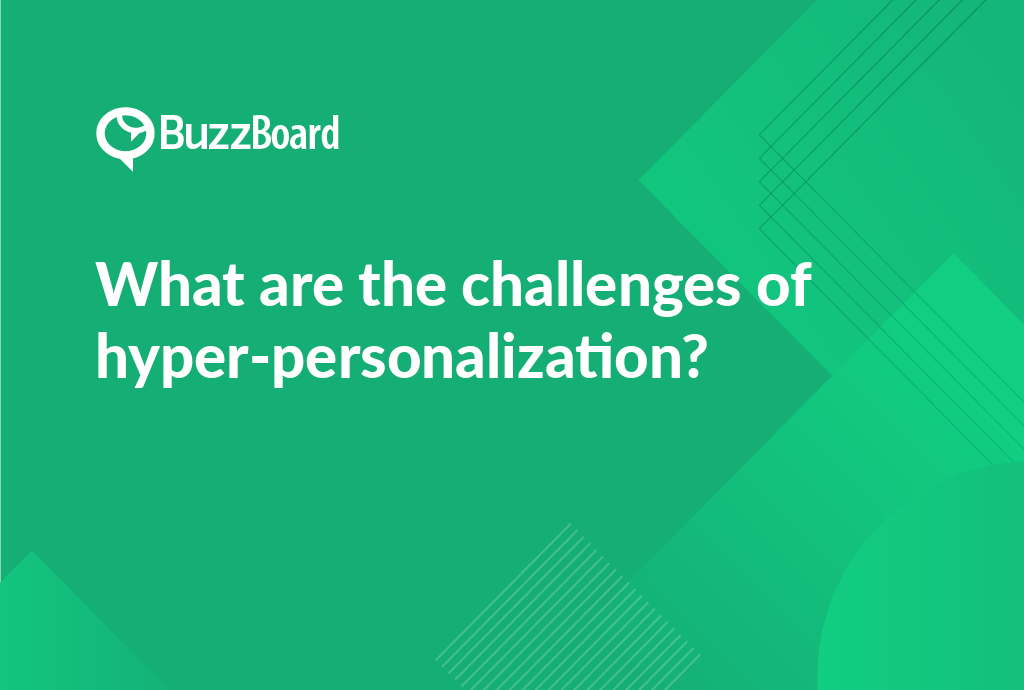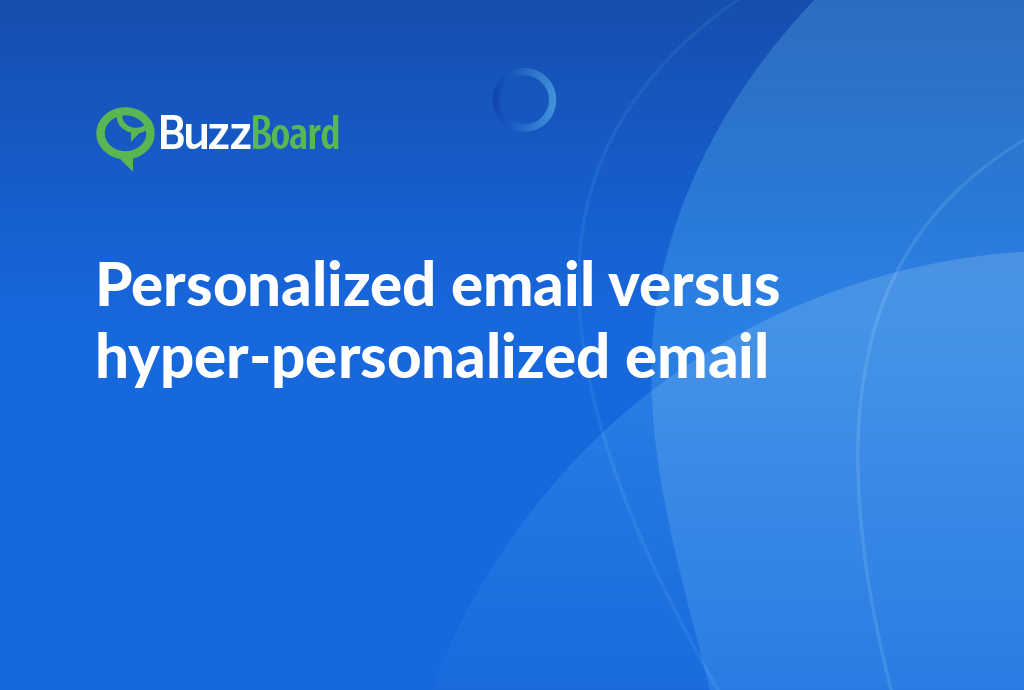What are the challenges of hyper-personalization? Hyper-personalization, a marketing strategy that uses data and AI to tailor experiences to individual customers, comes with several challenges. One major hurdle is data quality and accuracy, as incorrect or incomplete data can lead to ineffective personalization. Another challenge is the need for significant investments in technology and infrastructure to support the processing and analysis of large amounts of data. Additionally, hyper-personalization can be overwhelming for customers, leading to fatigue and decreased engagement. Furthermore, it requires a deep understanding of customer behavior and preferences, which can be difficult to achieve. Finally, hyper-personalization can also raise privacy concerns, as it involves collecting and analyzing sensitive customer data. To overcome these challenges, businesses must prioritize data quality, invest in the right technology, and strike a balance between personalization and customer comfort.
Discuss the Concept of Hyper-Personalization in Digital Marketing and Its Rising Importance
In the realm of digital marketing, hyper-personalization is swiftly becoming a pivotal tool. Hyper-personalization elevates customer profiling by providing real-time solutions, which derive from data such as past interactions and predictive analytics. This process facilitates more effective customer conversations.
However, hyper-personalization is not without challenges. Numerous digital marketing agencies encounter hurdles with hyper-personalization due to its demands for technological sophistication, in-depth learning algorithms, and a thorough knowledge of customer behaviors. Tackling these obstacles isn’t simple, but the end results provide successful and targeted interactions that outweigh the difficulties.
Hyper-personalization has the potential to revolutionize the way small and local businesses approach digital marketing, enabling them to connect with specific audiences in a more meaningful and impactful way. By leveraging data and analytics, businesses can create personalized, timely, and relevant messaging that resonates with their target audience, fostering deeper connections and driving conversions.
The shift towards hyper-personalization marks a significant departure from the traditional mass advertising approach, where businesses would cast a wide net in the hopes of catching a few fish. Instead, hyper-personalization allows businesses to tailor their messaging to specific individuals or groups, increasing the likelihood of engagement and conversion.
However, incorporating hyper-personalization into a digital marketing strategy is not without its challenges. Sales representatives at digital marketing agencies must be aware of these challenges and develop strategies to overcome them. Some of the key challenges include:
- Data quality and accuracy: Hyper-personalization relies on high-quality and accurate data to create personalized messages. Businesses must ensure that their data is up-to-date, accurate, and comprehensive to avoid mis-targeting or mis-representing their audience.
- Technical infrastructure: Implementing hyper-personalization requires a robust technical infrastructure, including data management platforms, customer relationship management systems, and marketing automation tools. Businesses must invest in the necessary technology to support their hyper-personalization efforts.
- Content creation: Creating personalized content that resonates with each individual or group can be a significant challenge. Businesses must develop a content strategy that is scalable, flexible, and adaptable to different audience segments.
- Balancing personalization with scalability: Hyper-personalization requires a delicate balance between personalization and scalability. Businesses must ensure that their efforts are scalable and can be replicated across different audience segments, while still maintaining the personal touch.
Despite these challenges, the benefits of hyper-personalization far outweigh the costs. By incorporating hyper-personalization into their digital marketing strategy, businesses can:
- Increase customer engagement and loyalty: Personalized messaging and experiences can create a deeper connection with customers, leading to increased loyalty and retention.
- Drive conversions and sales: Hyper-personalization can increase the likelihood of conversion by providing customers with relevant and timely offers and promotions.
- Gain a competitive edge: Businesses that adopt hyper-personalization can differentiate themselves from competitors and establish a unique brand identity.
- Improve customer insights: Hyper-personalization provides businesses with valuable insights into customer behavior, preferences, and needs, allowing them to refine their marketing strategy and improve customer experiences.
Hyper-personalization is a powerful tool that can help small and local businesses connect with their target audience in a more meaningful and impactful way. While there are challenges to overcome, the benefits of hyper-personalization make it a worthwhile investment for businesses looking to stay ahead of the competition and drive growth.
Common Challenges Associated With Implementing Hyper-Personalization Strategies
Implementing hyper-personalization strategies is a crucial component of digital marketing, allowing businesses to tailor their messages and offerings to individual customers’ preferences, behaviors, and needs. However, when it comes to small and local businesses, the process of hyper-personalization can be more complex and challenging. Recognizing and navigating these challenges is essential to enhance conversations and yield better results.
One of the primary obstacles to hyper-personalization is the collection and analysis of customer data. Small and local businesses often lack the resources and infrastructure to accumulate and analyze large amounts of customer data, which can limit their ability to personalize their marketing efforts. This can be attributed to several factors, including limited budget, lack of technical expertise, and limited customer base. As a result, these businesses may struggle to develop a comprehensive understanding of their customers’ needs, preferences, and behaviors, making it difficult to create targeted and personalized marketing campaigns.
Another significant challenge is maintaining the relevance of personalized content. Crafting a personalized message is just the first step; ensuring that this content remains timely and fitting is a continuous task that requires ongoing effort and attention. Small and local businesses may not have the resources or expertise to continuously monitor and update their content, which can lead to a disconnect between the personalized message and the customer’s current needs and preferences.
Furthermore, a major limitation of hyper-personalization is the risk of seeming intrusive. Businesses must strike a balance between personalization and customer comfort, as overly personalized messages can be perceived as invasive or even creepy. Small and local businesses must be mindful of this risk and ensure that their personalization efforts are respectful and considerate of their customers’ boundaries.
Despite these challenges, the adoption of hyper-personalization remains crucial in today’s digital marketing landscape. By tackling these issues directly, marketing agencies can better serve their small and local business clients and help them stay competitive in the market. To overcome these hurdles, marketing agencies must possess an in-depth understanding of the market landscape, coupled with commitment and agility.
Some strategies that marketing agencies can employ to overcome these challenges include:
- Developing targeted and personalized marketing campaigns that are tailored to specific customer segments or demographics
- Utilizing data analytics tools to collect and analyze customer data, and to identify patterns and trends in customer behavior
- Creating content that is relevant, timely, and fitting, and that is continuously updated to reflect changes in customer needs and preferences
- Ensuring that personalized messages are respectful and considerate of customer boundaries, and that they do not cross the line into intrusiveness
- Providing ongoing support and training to small and local businesses, to help them develop the skills and expertise needed to implement hyper-personalization strategies effectively.
By adopting these strategies and approaches, marketing agencies can help small and local businesses overcome the challenges of hyper-personalization and achieve better results in their digital marketing efforts.
Explain Various Hyper-Personalization Limitations That Digital Marketing Agencies Often Encounter
Hyper-personalization has revolutionized the digital marketing landscape, enabling agencies to craft tailored experiences that resonate deeply with their target audiences. However, achieving this level of personalization is not without its challenges. In fact, several obstacles can hinder the success of hyper-personalization efforts, making it essential to understand and overcome these limitations.
One of the primary hurdles is data collection. Accurate and comprehensive data is the foundation upon which personalization is built. However, issues of privacy, data breaches, or lack of consumer participation can significantly impede these efforts. For instance, consumers may be hesitant to share their personal information, or data breaches can compromise the integrity of the data. Moreover, the sheer volume of data can be overwhelming, making it challenging for smaller agencies to process and analyze it in real-time.
Another significant challenge is achieving the right balance in personalizing content. Over-personalization can be perceived as invasive, making customers feel uncomfortable or even uneasy. On the other hand, under-personalization can result in irrelevant content that fails to resonate with the audience. Therefore, it is crucial for businesses and their sales representatives to strike an optimal balance between personalization and relevance. This requires a deep understanding of the target audience, their preferences, and behaviors, as well as the ability to adapt content to meet their evolving needs.
Sustaining the authenticity of the brand message while personalizing it for diverse demographics is another significant challenge. The message often needs to be diluted or adjusted to accommodate different audience segments, which can lead to inconsistency in brand voice and tone. This can be particularly challenging for brands with a strong, distinctive voice, as they may struggle to maintain their unique identity while still personalizing their message.
To overcome these challenges, it is essential to prioritize the customer experience and focus on building a deeper understanding of their needs, preferences, and behaviors. This requires a data-driven approach, leveraging advanced analytics and machine learning algorithms to process and analyze large datasets in real-time. Additionally, businesses must be transparent about their data collection and usage practices, ensuring that customers feel comfortable sharing their information.
By surmounting these challenges, businesses can create a more personalized and engaging customer experience that drives loyalty, retention, and ultimately, conversion. The correct balance of personalization will not only boost customer engagement but also significantly impact conversion rates. In today’s competitive landscape, hyper-personalization is no longer a luxury, but a necessity for businesses looking to stay ahead of the curve and build lasting relationships with their customers.
Ways of Overcoming Challenges in Hyper-Personalization to Foster More Effective Conversations With Customers
The digital marketing landscape has undergone a significant transformation, giving rise to the trend of hyper-personalization. This phenomenon involves offering highly customized products, content, or services to customers based on their unique needs, preferences, and habits. To achieve this level of personalization, marketers are leveraging cutting-edge technologies such as artificial intelligence, machine learning, and big data analytics. However, navigating the complexities of hyper-personalization can be daunting, especially for sales representatives.
One of the primary challenges associated with hyper-personalization is striking a balance between providing personalized experiences and respecting consumer privacy. Excessive personalization can lead to feelings of discomfort, intrusion, or even mistrust. Therefore, it is essential to adopt a prudent approach to data collection and use, ensuring that customers’ personal information is handled with care and transparency.
Another crucial aspect of overcoming the hurdles of hyper-personalization is maintaining transparency in your methods. It is vital to inform customers about how their data will be used, the potential benefits they can anticipate, and the measures you have taken to protect their privacy. This approach can help build trust with customers, encouraging them to willingly share relevant information and fostering a sense of loyalty and commitment.
To encourage productive conversations and build meaningful relationships with customers, personalizing messages is crucial. However, simply inserting a customer’s name into an email or message is not enough. To truly personalize, sales representatives must strive to comprehend the customer’s distinct challenges, pain points, and goals. By offering relevant solutions and tailored recommendations, you can demonstrate that you value their business and are invested in their success. This approach can influence purchasing decisions, drive loyalty, and ultimately, drive revenue.
In addition to personalizing messages, it is also essential to personalize the overall customer experience. This can be achieved by tailoring the content, tone, and language used in marketing communications to resonate with each individual customer. By doing so, you can create a sense of connection and empathy, making customers feel seen, heard, and understood.
Furthermore, hyper-personalization requires a deep understanding of customer behavior, preferences, and motivations. This can be achieved through the use of data analytics, customer feedback, and social listening. By analyzing customer data and behavior, you can identify patterns, trends, and correlations that can inform your marketing strategies and help you create more effective, targeted campaigns.
While the journey to hyper-personalization is fraught with potential obstacles, conquering these challenges can lead to stronger, more authentic relationships with customers. By adopting a transparent, customer-centric approach to data collection and use, personalizing messages and experiences, and leveraging data analytics to inform your marketing strategies, you can create a competitive advantage and drive business success.
Delve Into the Benefits of Personalizing Marketing Efforts While Addressing Potential Pitfalls
It’s undeniable that digital marketing has become a vital tool for businesses of all sizes to reach their target audience and drive growth. However, for small and local businesses, digital marketing is particularly crucial for building strong, personal connections with their customers. By intensifying their marketing efforts, these businesses can foster effective conversations and genuine relationships with their client base, ultimately leading to increased loyalty and retention.
But, as with any powerful tool, hyper-personalization also comes with potential pitfalls. An overemphasis on personalization can result in marketing that feels intrusive or forced, creating discomfort or disconnection among customers. This can be particularly damaging for small and local businesses, which rely heavily on word-of-mouth and customer loyalty to drive their success.
To avoid these pitfalls, it’s essential to strike a balance between personalized messaging and respect for your customers’ privacy. This means crafting relevant, engaging content that respects your audience’s boundaries while delivering a tailored message that adds value to their lives. To achieve this balance, businesses must be willing to continuously test, analyze, and adapt their strategies, fostering a customer-first mentality and creating an ethical data collection and usage policy.
Personalizing your marketing efforts should aim to provide added value to your customers, addressing their specific needs and concerns, and building a relationship based on trust. This can be achieved by leveraging data and analytics to understand your customers’ behaviors, preferences, and pain points, and then using this information to create targeted, relevant content that resonates with them.
To explore personalizing your marketing efforts while mitigating potential pitfalls, consider delving into external resources like case studies, expert analyses, and industry reports. Don’t hesitate to use professional digital marketing tools and services, which can offer valuable data insights and strategies to help you stay ahead of the curve.
In today’s constantly evolving digital landscape, staying informed and adaptable is crucial for success. One way to achieve this is by regularly updating your knowledge and skills through online learning platforms, industry workshops, or networking events. By staying up-to-date on the latest trends, best practices, and technologies, you can ensure that your marketing efforts remain effective and relevant.
Ultimately, the goal of personalizing your marketing efforts is to make your marketing more effective and efficient. The key to overcoming challenges is to address them directly, learn from outcomes, and adjust your strategies as necessary. By taking a proactive and customer-centric approach to marketing, you can build strong, lasting relationships with your customers, drive growth and revenue, and stay ahead of the competition.
Some additional tips to keep in mind when personalizing your marketing efforts include:
- Start small and test your approach before scaling up
- Use data and analytics to inform your decisions, rather than relying on intuition or assumptions
- Be transparent and honest with your customers about how you’re using their data
- Continuously monitor and measure the effectiveness of your marketing efforts, and make adjustments as needed
- Prioritize building trust and relationships with your customers, rather than simply trying to make a quick sale
- Stay up-to-date on industry trends and best practices, and be willing to adapt your approach as the landscape evolves.
By following these tips and staying focused on your customers’ needs and concerns, you can create a personalized marketing strategy that drives real results and sets your business up for long-term success.
Conclusion
Hyper-personalization is a powerful marketing strategy that has the potential to revolutionize the way businesses interact with their customers. By leveraging data and AI to tailor experiences to individual customers, businesses can create deeper connections, increase engagement, and drive conversions. However, as we’ve seen, hyper-personalization also comes with its own set of challenges, from data quality and accuracy to the need for significant investments in technology and infrastructure.
To overcome these challenges, businesses must prioritize data quality, invest in the right technology, and strike a balance between personalization and customer comfort. They must also be mindful of the potential privacy concerns associated with hyper-personalization and take steps to ensure that customer data is collected and used responsibly.
Ultimately, the key to successful hyper-personalization is to find a balance between personalization and customer comfort. By doing so, businesses can create experiences that are both tailored to individual customers and respectful of their privacy. As the marketing landscape continues to evolve, it’s clear that hyper-personalization will play an increasingly important role in helping businesses build strong, lasting relationships with their customers.








